“Tumbaga Saga” Treasure of the Conquistadores in Mexico
by Agustin “Augi” Garcia-Barneche
There was no way to anticipate the type of treasure the Marex company would find in the summer of 1992. No one—and certainly not Marex—was scouring the Bahamian shoals for a shipwreck carrying treasure of the conquistadors in Mexico.
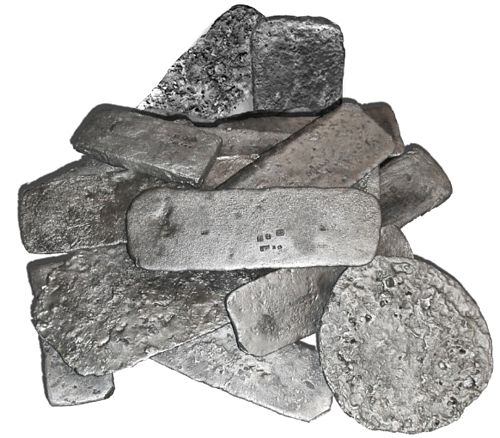 The recovery by Marex of over two hundred gold and silver bars from a dispersed wreck site passed almost unnoticed in the archeological community For details of the company and logistics of the recovery, see article entitled “Tumbaga Bars” written by Bob “Frogfoot” Weller for Treasure Quest magazine (Vol. 9, No. 2. 15, March-April 1998). Marex subcontracted a boat managed by John McSherry in the summer of 1992 to find the Maravillas wreck, but in the process he discovered the “Tumbaga” wreck.. These bars were sent to Florida for conservation by Douglas R. Armstrong, who immediately sensed the importance of these ingots and called them “silver tumbaga,” referring to a metal that is a mix of gold, silver and copper, in this case primarily of silver. According to Armstrong, “tumbaga” was a word adopted by the Spanish from Indians in South America to describe a quasi-alloy of gold, copper and silver. It came to signify a low-quality alloy of gold and silver. Armstrong went beyond his assigned task of preserving the bars to undertaking a scientific study of them. His study, published privately in 1993, combined metallurgical analysis with a history of assaying practices in sixteenth-century Spanish MexicoSee Douglas R. Armstrong, Tumbaga Silver for Emperor Charles V of the Holy Roman Empire: the Study of a Large Trove of Early 16th Century Spanish Silver Bars Recovered from a Shipwreck off Grand Bahama Island. Palm Bay, Florida, Author, 1993.
The recovery by Marex of over two hundred gold and silver bars from a dispersed wreck site passed almost unnoticed in the archeological community For details of the company and logistics of the recovery, see article entitled “Tumbaga Bars” written by Bob “Frogfoot” Weller for Treasure Quest magazine (Vol. 9, No. 2. 15, March-April 1998). Marex subcontracted a boat managed by John McSherry in the summer of 1992 to find the Maravillas wreck, but in the process he discovered the “Tumbaga” wreck.. These bars were sent to Florida for conservation by Douglas R. Armstrong, who immediately sensed the importance of these ingots and called them “silver tumbaga,” referring to a metal that is a mix of gold, silver and copper, in this case primarily of silver. According to Armstrong, “tumbaga” was a word adopted by the Spanish from Indians in South America to describe a quasi-alloy of gold, copper and silver. It came to signify a low-quality alloy of gold and silver. Armstrong went beyond his assigned task of preserving the bars to undertaking a scientific study of them. His study, published privately in 1993, combined metallurgical analysis with a history of assaying practices in sixteenth-century Spanish MexicoSee Douglas R. Armstrong, Tumbaga Silver for Emperor Charles V of the Holy Roman Empire: the Study of a Large Trove of Early 16th Century Spanish Silver Bars Recovered from a Shipwreck off Grand Bahama Island. Palm Bay, Florida, Author, 1993.
In April of 1993 a small portion of the bars were sold through Christie’s auction house in London, but the sale attracted little interestSee Christie’s, Coins, Banknotes, Commemorative Medals and Treasure from Spanish Shipwrecks (London, April 1993). Frank Sedwick, Ph.D., a Florida numismatist, purchased most of the lots; he felt that these bars were the earliest and rarest silver bars ever salvaged from a Spanish shipwreck in the New World. Dr. Sedwick, Mr. Armstrong and a few other numismatists suspected that this group of “tumbaga” bars might be treasure that was being sent home to Spain by the first generation of conquistadors in the New World. Dr. Alan Craig, a professor at Florida Atlantic University and researcher for the Division of Historical Resources for the State of Florida, was quoted in the Christie’s auction catalog as saying: “[This] material… has no equal in the museum collections familiar to me. It represents booty seized in some of the very first Spanish entradas into Indian territory…. These tumbaga bars are the actual physical evidence of these historic events that writers have written about for centuries, but never seen.”ibid., 27
Very few people took the opportunity to examine these remarkable bars before they disappeared into private collections in the 1990s. They do not resemble at all the treasure bars found on the Atocha (1622), the Maravillas (1656) or the 1715 Fleet treasure wrecks. Even with a cursory examination of the bars, it is obvious that they were made without, and probably prior to, official specifications. These ingots are an unusual and uneven mixture of metals hastily reduced into portable bars and show signs of a very primitive method of assaying and smelting, just what one would expect to find if the source of the precious metals was the silver and gold artifacts of native people. This was the legacy of Cortés, the conqueror of these natives, who probably never envisioned a smelting or minting operation. In addition, rivalries and internal dissention were as much of a threat to the Spaniards as to the confused Aztecs who questioned whether their conquerors were good or evil gods. The bars are fascinating relics of this era of conquest when the conquistadors rapaciously extracted loot from the Aztecs and other tribes like the Tarascans and hurriedly shipped it home to Spain as ingots. The recovery of the “tumbaga” bars, as they are most often called, has been one of the most important finds in the history of treasure hunting and furthers our understanding of very early Spanish colonial practices.
I first became aware of the Marex treasure about a decade after the London sale. Because I was already familiar with the gold and silver bars usually found on Spanish New World wrecks, I immediately recognized the “tumbaga” bars as something different. After reading Armstrong’s monograph, I knew the bars deserved further research into their origin and history.
The story of the Tarascan conquest relies to a significant degree on The Conquest of Michoacán 1521-1530, written by J. Benedict Warren. Its original Spanish version was part of the collection Estudios Michoacanos VI and contains documentary information about the source of the silver “tumbaga” bars and also offers an explanation for the unique copper-silver alloy used in the bars. “Tumbaga” bars are much more interesting than later Spanish treasure bars for several reasons. The later bars were governed by rigorous regulations about how they were made and marked and how ownership was registered. While “tumbaga” bars have what at first seem to be indecipherable markings, by comparing them with later bars we find an explanation for some of these markings, specifically the different types of numeric stampings and codes. The major difference between “tumbaga” bars and later specimens is that “tumbaga” bars are not official foundry products. They were melted mixtures of precious metals and artifacts with a great variety in the fineness or purity of the component metals. In other words, each bar is unique.
The Account of Bernal Díaz del Castillo
In Chapter 104 of his work Historia verdadera de la conquista de la Nueva EspañaBernal Díaz del Castillo, Historia Verdadera de la Conquista de la Nueva España. Escrita por el Capitán Bernal Díaz del Castillo, uno de sus Conquistadores. tomo IV. Madrid, Imprenta de Don Benito Cano, 1796, Díaz del Castillo first alludes to the greed of the conquistadors, an issue addressed by Gómara as well“Cortés asked Tendile, an official of the Aztec king, if Montezuma had more gold. After his positive response, Cortés replied with this well-known statement: ‘Send me some of it, because I and my companions suffer from a disease of the heart that can be cured only with gold.’” Francisco López de Gómara, Cortés: The Life of the Conqueror by his Secretary (California: University of California Press, 1966), 58. Cortés asked Montezuma, lord of Mexico, for more gold and ordered him to collect treasure from other caciques, or leaders of the area. At first Montezuma balked at having to ask for treasure from others of lower rank, but, after some negotiations, persuasion and force, Cortés got his treasure. Then there was the problem of converting looted artifacts into a more portable and measurable form. Cortés had to melt down the artifacts into solid ingots or bars and then assay the fineness of the bars, and only after that could he pay the royal fifth that was shipped back to Spain. Significantly, from the same chapter we have a reference to the “tax stamp” used by Cortés and the first mention of melting treasure into bars:
The cuño had the mark of Las Armas Reales like on a 1 real and the size of a Tostón de a cuatro. The fine jewelry pieces were not marked in order not to destroy them, and to weigh all the bars of gold and silver and the jewels we had to use weights or a balance, so Cortés thought that it would be good to make some scales of iron up to one arroba [equal to 11.5 kilos], with weights of one arroba, half an arroba, two pounds, one pound, half a pound, four ounces and others, and they were not very exact, but to the half ounce more or less. At each weighing that was done, the officials of the king said how much gold was in it, some [already] made into bars, plus the ores from the mines, and the pieces and jewels totaled more than six hundred thousand pesos, not counting the silver and other jewels which were not evaluated.Bernal Díaz del Castillo, Historia Verdadera de la Conquista, 201
That process created its own set of issues because Cortés and his conquistadors did not even have an official seal or cuño to mark the bars to certify that they had collected the royal fifth for the king. At that time it was illegal to ship bars without this seal. Because Cortés had no silversmith traveling with him, the manufacture of the cuño in iron had to be undertaken by one of his blacksmithsAs a reference the book Hierros Forjados [Forged Iron], written by Antonio Cortés in 1935, is a very interesting source referring to the importance of a blacksmith at the time of the conquest. Blacksmiths had to execute the delicate markings for the tax seal, an accurate work usually done by plateros and assayers. Also Cortés ordered his blacksmiths to forge markings for branding natives as slaves.. According to Antonio CortésAntonio Cortés, Hierros Forjados (México: Talleres Gráficos del Museo Nacional de Arqueología, Historia y Etnografía, 1935), 39. , Bernal Díaz del Castillo mentioned several times the blacksmiths of Hernán Cortés, but apparently no proper names were given. This fact makes us question the difference and importance that a platero, or silversmith, had compared to a blacksmith. The work also shows a plate with some of the different forged iron markings approved and used by the time of Cortés to mark livestock. The full plates of all 144 markings can be found in an official decree (Acta del Cabildo de la Ciudad de México) of 16 June 1529. What is interesting about these plates is that they show the complexity and style of the markings made by the blacksmiths, who in some cases had obvious silversmith ability. Of course these marks are not related to the bars, but they show what a common blacksmith could do.
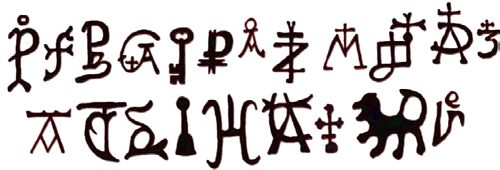
Some of the complex markings forged in iron by blacksmiths in the late 1520s
The First Foundries in New Spain and the Melting of Loot Seized by the Conquistadors
During the unstable period of the Spanish conquest of the Aztecs and Tarascans, a royal decree from Spain dated 14 September 1519, authorized Hernán Cortés to assay, mark and affix tax stamps showing that the king’s fifth had been paid on the gold and silver gathered in great quantities in the wealthy Tenochtitlán area. To carry out this decree, Cortés used the palace of Montezuma’s father as a foundry, effectively the first foundry in the territory of New Spain. From the beginning the Spaniards exploited the native manpower by relying upon the able and experienced silversmiths of Azcapotzalco, a practice which later permitted them to establish even larger and more elaborate foundries Román Beltrán Martínez and Ramón Beltrán Martínez, “Primeras casas de Fundición,” Historia Mexicana, Jan.-Mar. 1952, 373-393.. The technique used by these natives can be seen in this drawing from the Florentine CodexThe Florentine Codex is the name given to twelve volumes created under the supervision of Bernardino de Sahagún right after the Spanish conquest in the mid-1500s.. This technique consisted of using canes to blow into a pot in order to reach the proper temperature to melt the metal and pour it into a mold. This was not a perfect technique and sometimes it was necessary to repeat the heating processThe process is described as “soplando con unos canutos de caña” (blowing with canes). See Francisco de Cárdenas y Espejo, Joaquín Francisco Pacheco and Luis Torres de Mendoza, Colección de documentos inéditos, relativos al descubrimiento, conquista y organización de las antiguas posesiones españolas de América y Oceanía, sacados de los archivos del reino, y muy especialmente del de Indias. Competentemente autorizada 42 vol. XII (Madrid: 1864), 260-268..

Florentine Codex (chapter 17) – Spanish and allies melting down loot (note the arm and leg in the foreground are just to show how the jewelry was worn and do not signify that they were physically cut off)
According to Bernal Díaz del Castillo, the smelting of metals—specifically gold—was not new to the Spaniards, as many of those who followed Cortés to Mexico had seen the foundries in Cuba and Santo Domingo where guanín, a mixture of low-purity gold and bronze, was smelted Francis Augustus MacNutt, Fernando Cortés and the Conquest of Mexico, 1485-1547 (New York: G.P. Putnam’s Sons, 1909), 17..
By 1521 Cortés had relocated the Spanish foundry to Coyoacán at the southern end of Tenochtitlán, supposedly requisitioning one of the rooms in his own house for the job. Changes to the operation and oversight of the foundry were put into place by royal decree in 1522 with the primary change being the addition of various foundrymen who helped to consolidate the administration and to create new posts relating to specific tasks within the foundry. Officials such as Julián de Alderete, royal treasurer in Tenochtitlán, and Alonso de Grado and Bernardino Vázquez de TapiaLawrence Leslie Anderson, The Art of the Silversmith in Mexico, 1519-1936, New York: Oxford University Press, 1941, p.123., two other conquistadors of high reputation, were brought in to oversee the melting and assaying of the proceeds of the ongoing conquest by Cortés, an amount equal to more than 130,000 castellanosStandard unit of value at the time (1 castellano=4.6 grams of gold at 23-3/4 karat).. The royal treasurer was in charge of the taxing and receipt of the royal fifth. Naturally, this second Mexican foundry did not yield coins marked in the same manner as those made at the official mints in Spain Román Beltrán Martínez and Ramón Beltrán Martínez, op. cit., 373-393.. Instead it produced small cut pieces of gold known as tejos or tejuelos de oro, or more commonly oro corriente, and silver pieces called tejuelos de plata, or more commonly plata corriente. These gold and silver pieces, stamped with the blow of a hammer, bore no resemblance to properly struck coins.
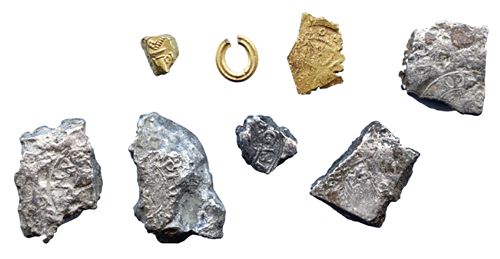
Oro and plata corriente (and money chain link) – ex Jorge Proctor collection.
According to the historian Lucas Alamán in his book Disertaciones Sobre la Historia de Méjico [Dissertations on the History of Mexico], by resolution of the council on 6 April 1526, all previous discs, gold ingots, oro corriente, tejuelos de tepuzque and (in some references and old documents) oro de guanín (“tepuzque” and “guanín” referring to low-fineness metals) were to be recalled within four years Lucas Alamán, Disertaciones sobre la historia de la República Mejicana, desde la época de la conquista que los españoles hicieron, hasta la independencia (Habana: Imprenta de La Voz de Cuba, 1873), 218. Lucas Alamán was a controversial figure in 19th-century Mexico. A scientist, politician, historian, diplomat, and writer, he was conservative by nature and expressed a nostalgia for monarchic rule. He was an influential politician in the early years of the Mexican Republic and favored a strong central government. Alamán was also instrumental in creating the Mexican national archives. Along with its comprehensiveness, Alamán’s history is also notable for its favorable view of the Spanish presence in Mexico.. Low-purity gold like that found in oro de guanín had led to corruption and dishonesty at the foundry when pieces were incorrectly assayed or marked with incorrect fineness, resulting in a lower tax, or quinto. Alamán states that the tejuelos were to be returned to the foundry house to be exchanged for others with correct purity or fineness. The owners would pay the usual tax and assayers would correct the recorded fineness. These new pieces would bear a large, clear fineness mark so that there would be no doubt about their authenticity or their purity. Two overseers at the mint with good reputations among the locals, Juan Celada and Diego Martínez, were in charge of the re-assayed pieces of gold. As for the silver, Alamán states that inferior-quality silver was called plata de tepuzque, and in fact the name tepuzque remained in the local vernacular, applying not only to silver and gold but also to people and things having a “false gloss”. Despite the reputation of these pieces, they served as money in the absence of proper coinage and circulated as late as the 1550sibid., 113..
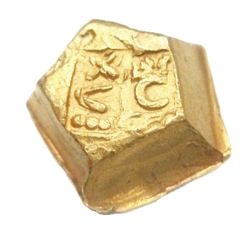
Coin-like gold “tejuelo” (Sedwick specimen, now in a private collection)
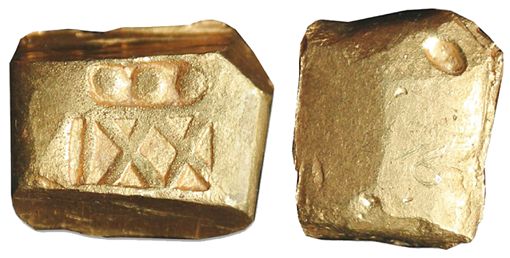 Small, coin-like cut piece of a gold “finger” bar, 28.5 grams, marked with fineness XXI and three dots (21-3/4K), from the Santa Margarita (1622). 3/4” x 1/2” x 1/4”.
Small, coin-like cut piece of a gold “finger” bar, 28.5 grams, marked with fineness XXI and three dots (21-3/4K), from the Santa Margarita (1622). 3/4” x 1/2” x 1/4”.
Until recently, no tejuelos de tepuzque were known to have survived the recall. The first of these surviving rarities, also from the “Tumbaga wreck”, surfaced in the original 1993 Christie’s sale in London, but no one recognized them for what they were. Outside the auction Dr. Frank Sedwick and his son Daniel Sedwick, also a professional numismatist specializing in Spanish colonial and shipwreck coinage and artifacts, acquired what they considered the best of the known cut gold pieces: a pentagonal chunk with all the prescribed markings bold and full, including a crowned “C” for King Charles and a fineness marking of “XV” followed by a column of three dots indicating 15¾ karats. This was also the most coin-like of the recovered tejuelos, as it was nearly exactly pentagonal in shape, about 7/8 inches in diameter, one-quarter inch thick, with sloping sides, markings on the top, and 23.8 grams in weight—almost exactly the weight of five gold castellano coins (at 4.6 grams per coin) or seven gold excelente de la granada coins (at 3.52 grams per coin). It was also the purest of the ten tepuzque gold pieces, as most of the others were somewhat copper-colored and one was clearly marked “VIIII” for (only) 9 karats. Other examples in higher-karat gold were recovered from a later wreck, the so-called “Golden Fleece wreck” of ca. 1550 See lot 51 in Treasure Auction #3 (May 29, 2008) by Daniel Frank Sedwick, LLC. This piece was described as a small cut gold ‘coin,’ with a fineness of 19½ karats, weighing approximately 14.2 grams, and measuring approximately ¾” x 5/8” x 1/8”. It was recovered from the “Golden Fleece wreck,” which sank circa 1550 in the northern Caribbean..
Later in 1526, a Spanish official named Luis Ponce de León arrived in Mexico with new seals to mark the gold and silver issued there along with a royal directive in which the king would consider establishing an official mint Pilar González Gutiérrez, Creación de casas de moneda en Nueva España (Alcalaá de Henares: Servicio de Publicaciones, Universidad de Alcalá, 1997), ensayos y documentos, 26, 75.. Several more attempts to establish a mint were considered in the ensuing years, and finally, in a decree dated 11 May 1535, and signed by Queen Juana Note that technically Charles co-reigned with his mother Joanna, who was mentally unstable. (mother to Charles), the new Mexican Viceroy Antonio de Mendoza Mendoza was well acquainted with mint practice, having been, at one time, treasurer of the mint in Granada. See Wilbur T. Meek, The Exchange Media of Colonial Mexico (New York: King’s Crown, 1948), 96. received authorization for the opening of a mint, and the first official mint of the Americas became a reality.
The Tarascan Culture of Michoacán
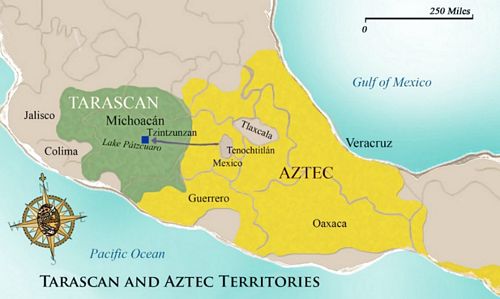
The Tarascan state was an important pre-Columbian civilization of Mesoamerica. Its territory coincided approximately with the present-day Mexican state of Michoacán. The Tarascan capital was located at Tzintzuntzan, on the banks of Lake Pátzcuaro.
The name “Tarascan” (tarasco in Spanish) comes from the word “tarascue,” which means “son-in-law” or “father-in-law” . Its application to the pre-Columbian people of Michoacán seems to stem from some early marriages between Spaniards and the daughters of the Tarascan caciques. When some of their new family members were introduced to them as tarascue, the Spaniards mistakenly interpreted this as the name of the entire people J. Benedict Warren, The Conquest of Michoacan: The Spanish Domination of the Tarascan Kingdom in Western Mexico, 1521-1530, 6..
At the time of the Spanish conquest the Tarascan empire was the second largest territory in Mexico. Founded in the early fourteenth century, it was overrun by the Spanish in 1530 after a brief struggle that began in the late 1520s. The people of the Tarascan empire were mostly P’urhépecha or Tarascos in ethnic origin, but the empire also absorbed other groups such as the Nahua, Otomi, Matlatzinca and Chichimec. These ethnic groups were for the most part peacefully assimilated into P’urhépecha culture.
The Tarascan state was contemporary to the Aztec empire, with whom they were chronically at war and fought several major battles. Because of its relative isolation within Mesoamerica, the Tarascan state developed many cultural elements dissimilar from those of its Mexican neighbors and other Mesoamerican cultures. It was particularly notable for being among the few Mesoamerican civilizations able to work metal for tools and ornamentation. Tarascan metallurgy was a complex technology and a major source of wealth for the ruling dynasty Helen P. Pollard, “Political economy of prehispanic Tarascan metallurgy” (American Antiquity, 1987) 52(4), 741..
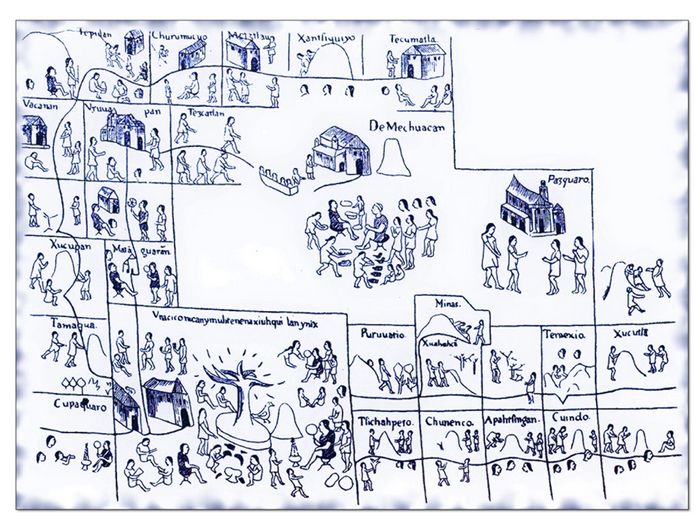
Section of a 263x203cm piece of cloth known as the Lienzo de Jicalán (or Lienzo de Jucutacato).
This ca. 1565 pictographic source shows metallurgy and mining activities (mainly copper) in the area of Michoacán
during the first decades of the viceroyalty of New Spain and in the large panel at the bottom (enlarged below)
very clearly shows the smelters working the metal into ornaments.
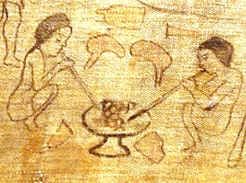
The Tarascan Conquest by Cristóbal de Olid in 1522 and the Link between the Metal of Michoacán and the “Tumbaga” Wreck Treasure
Cristóbal de Olid was born in Zaragoza, Spain, but grew up in the household of the Governor of Cuba, Diego Velázquez de Cuéllar. In 1518 Velázquez sent Olid to Mexico to relieve Juan de Grijalva. En route to Mexico, Olid’s ship wrecked in a hurricane and he barely made it back to Cuba. On 10 January 1519, Olid again sailed for Mexico, this time with Hernán Cortés’ fleet, and arrived in time to take an active part in the conquest of Mexico. The “tumbaga” story begins in 1522, almost a year after the fall of Tenochtitlán, when Hernán Cortés sent one of his top lieutenants to Michoacán to conquer the Tarascans. Another objective of the expedition, according to Bernal Díaz del Castillo, was to get rid of some soldiers who were increasingly unhappy with Cortés and believed that Cortés had kept almost all the loot from the Tenochtitlán conquest for himself.
According to Cortés, the Michoacán expedition was undertaken because the Tenochtitlán loot had already been spent and divided, and he now had reports of new riches in the Tarascan Empire Hernán Cortés, Cartas de Relación (Mexico: Ed. Porrúa, 1979), 176.25 26 . It is not hard to believe that Cortés had kept most of the treasure for himself and his circle of trusted friends because he was under a great deal of pressure. Not only did he have no way of knowing what new demands would come from Cuba or the king of Spain or other people involved in the conquest, but he felt that his responsibility as sole commander of the conquest was immense. He had to make crucial decisions for which he would be held responsible without any way to consult his superiors. The person put in charge of the Michoacán expedition was one of Cortés’ best men, Captain Cristóbal de Olid. Olid had been at Cortés’ side throughout their time in Mexico and was part of the conquest in Tenochtitlán. Before Olid was sent to Michoacán, Cortés named him captain-general of one of the three divisions of his army J. Benedict Warren, op. cit., 50..
The expedition was organized and ready to go by the summer of 1522. In July the troops were on their way to Michoacán. The size of the Olid expeditionary force was surprisingly small, according to Cortés in an unpublished section of the Residencia de Cortés The list can be read in a modern Spanish version of La Conquista de Michoacán (1977) edited by Agustín García Alcaraz. Ibid., 42-43.27. The document lists all 174 Spaniards who went on the expedition. The list also records that there were Tlaxcaltecans (Spanish allies) who joined the expedition. Their total number is unclear and varies considerably according to different sources. Perhaps several thousand native allies accompanied Olid. The list was made at the end of the expedition in order to distribute the proceeds obtained from auctions of the gold, silver and the metal of Michoacán that the army brought back to TenochtitlánThe list can be read in a modern Spanish version of La Conquista de Michoacán (1977) edited by Agustín García Alcaraz..
The only contemporary account of the Olid expedition is contained in La Relación de Michoacán, which is the story as told to an anonymous author by a Tarascan nobleman known as “Don Pedro” to the Spanish. According to his account the encounter with the Spaniards was peaceful and the Tarascans agreed to cooperate because they knew what had happened to the Aztecs and probably because Olid was not as aggressive as other captains. Some looting was reported but no atrocities, at least in the first encounter. The Tarascan army numbered in the thousands, but when Olid arrived the Tarascans chose not to fight Shirley Gorenstein, “Introduction” in Taríacuri’s Legacy: The Prehispanic Tarascan State, by Helen Perlstein Pollard, from The Civilization of the American Indian series, vol. 209 (Norman, OK: University of Oklahoma Press, 1993), xiii–xx.. Instead Olid was greeted peacefully and given several ofrendas (offerings). This is the first time that a Spaniard had a taste of the treasures of Michoacán, which had been hoarded generation after generation since Tarascans mastered metallurgy. The Tarascans not only knew how to work the metal to create spectacular pieces, they also knew how to melt and harden the metal and work in different alloys. They were even good miners.
The first reaction of the chief of the Tarascans, Caltzontzin, was to offer a peace treaty to the Spaniards. Caltzontzin then gave some treasure to Olid, but the Spanish wanted more and found several chests with diadems, shields, discs, half moons and all sorts of ornaments, including some made out of a soft metal the Spanish were able to cut in two with a swordJ. Benedict Warren, op. cit., 54..
 From Los Tarascos by Nicolás León (1903), depicting natives carrying cargas
From Los Tarascos by Nicolás León (1903), depicting natives carrying cargas
The Tarascans did not mention this treasure because it was dedicated to their gods and thus untouchable for other purposes. In La Relación de Michoacán the anonymous author said that as many as twenty chests of gold and twenty chests of silver and other metals had been hoarded, and the natives called these “chuperi.” La Relación de Michoacán Cap XXVI: “20 chests were seized by the Spanish, later split into 40 cargas” The Spanish seized these chests and divided them into forty cargas (loaded bags) to transport them more easily. Native smelting centers were located around the Tarascan area and close to the mines to make transportation easier. The smelting practice was not new for the Tarascans since they were used to smelting copper ingots Helen P. Pollard, “Political economy of prehispanic Tarascan metallurgy,” American Antiquity, 1987, 52(4), 748.32 J. Benedict Warren, op. cit., 176.. The Tarascans also had other treasures deposited on an island in the middle of nearby Lake Apupato. According to the Relación, these treasures were put there by Caltzontzin’s great-grandfather, and on another island in the lake, called Xanecho, treasure was deposited by Caltzontzin’s father. On Xanecho the Tarascans had stored many shields or discs made from silver of a lower fineness; however, other items were reported to be of almost pure silver. The impure mix was achieved by hammering copper wrapped in silver, creating a “quasi-alloy”. A physical description of these treasures is hard to find and interpret, but hundreds of chests and discs and ornaments were mentioned in La Relación and the metal was described as una plata no muy fina (low fineness silver) or plata baja (low silver) or even plata dorada (golden silver), later also known as el metal de Michoacán.
There is also mention of two other islands in the lake, each with more and more treasure. According to the account in La Relación, there was sorting or separation of the precious metals according to whether the Spaniards thought each piece was more or less pure or some sort of an alloy. There is other documentary evidence that the treasure was sorted according to quality before it was melted and cast into what we now call “tumbaga” silver. This may also explain some of the markings on the “tumbaga” silver bars, in particular what I call the “R” code.
According to accounts in La Relación de Michoacán, the Spaniards established a foundry in Michoacán, but an official inspection in 1525 exposed the fact that the locals were not paying taxes and were doing a poor job of assaying metals. To avoid being taxed, they sold precious metals directly to merchants who smuggled them out of Mexico. Additionally, slaves, natives and even the Spaniards themselves privately refined Michoacán metal to avoid taxation altogether. Rodrigo de Albornoz, a Spanish auditor and colonial official in New Spain, highlighted the problems at the Michoacán foundry in a letter to the king dated 15 December 1525J. Benedict Warren, op. cit. p.176. He suggested the establishment of an “official foundry” in Michoacán where metals would be smelted and later shipped to Mexico City for refining. Because many of the “tumbaga” bars have two assay marks in different styles, they may have been subjected to a simple refining in Michoacán and a more professional, official refining in Mexico City at a later date, as suggested by Albornoz. This official report gives rise to the idea that our “tumbaga” silver bars may have been moved around Mexico surreptitiously for a few years before they were put on a ship that sank in the Bahamas. The theory that the “tumbaga” bars were composed of metals from Michoacán is supported by Hernán Cortés himself in letters he wrote to the Spanish king and emperor, Charles V, to inform him of his conquests in Mexico. These communications with the king were paramount to Cortés’ future in Mexico and beyond. In the fourth letter dated 15 October 1524, Cortés referred to his conquest of Michoacán and the unique mixture of silver, copper and gold for which that region was known.
The Metal of Michoacán and an Overlooked Connection with the “Silver Tumbaga” Bars
The term “silver tumbaga” is not technically correct since true “tumbaga” was a quasi-alloy composed mostly of gold and copper. It has a significantly lower melting point than gold or copper alone, and that is probably the reason the Tarascans, after experimenting with the way to achieve a casting of this metal, came up with this combination.
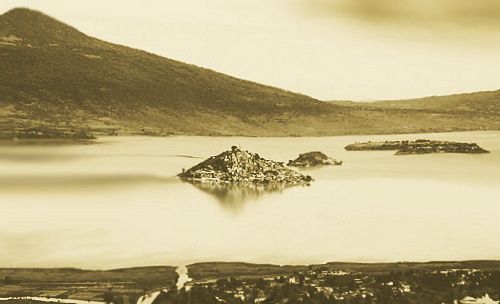
Lake Pátzcuaro and its islands
According to Dr. Dorothy Hosler, professor of archeology and ancient technology and author of The Sounds and Colors of Power: The Sacred Metallurgical Technology of Ancient West Mexico, the Tarascan culture often used an arsenic-bronze to produce silvery-looking artifacts; however, pieces like discs, pendants and other ornaments were probably produced with a copper-silver alloy hammered into sheet-metal. This was a common practice in Michoacán at the time of the conquest and later. According to Benedict Warren, this new metal was called “the Metal of Michoacán.” J. Benedict Warren, op. cit., 119 This hammered mixture of copper and silver sheets, which the Spaniards found hard to melt and assay, was the source of “silver tumbaga” bar metal. Most copper ores have some amount of arsenic, antimony, or nickel, which mix with the copper during smelting Smelting is not to be confused with melting. Smelting is the process by which fire is used to extract metal from ores.. These alloys are still dominated by copper, but the alloy has a lower melting point than pure copper, allowing for easier melting and casting. We know that copper alloy is much harder than pure copper after hammering it. The Tarascans discovered this fact as well.
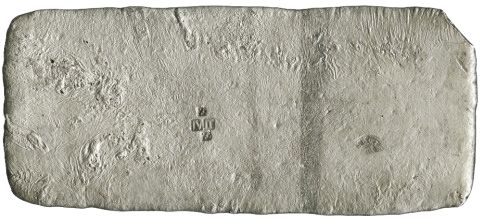 Mesoamerican metallurgy, one of the most varied and technically creative metallurgies of the pre-industrial world, was almost extinguished after the Spanish invasion Susan Toby Evans and David L. Webster, Archaeology of Ancient Mexico and Central America: an Encyclopedia (London: Routledge, 2001), 455.. Ironically, before almost destroying it, the Spanish exploited it. They reduced Tarascan treasure to bars by melting it in pots with a charcoal fuel while using some sort of bellows and then pouring the melt into simple molds. Several illustrations from Spanish colonial-era codices show this. This technique may be the reason why we find charcoal in some “tumbaga” bars. Certainly the temperature achieved was enough for the combination of alloys and metals. In order to work at lower smelting temperatures, natives were learning to combine metals from different sources. No two “tumbaga” silver bars are the same; however, a few shared the same mold and are therefore similar in shape and weight. These molds may have been made of clay or even carved charcoal, and lasted at the most four or five times based on the study for this in my book: The Tumbaga Saga: Treasure of the Conquistadors. There are about ten larger bars, but most weigh four to five pounds. Some of the shapes are interesting, especially the bigger bars. There are some we call “patties,” round heavy ingots with a lot of imperfections on bottom and top, probably made in a soft-ground mold. Some long, wide, flat ones look more like surfboards. According to Danny Lee, a collector in the field, the molds for these “surfboards” may have been made on the ground by using a flat shovel, whose shape they perfectly match.
Mesoamerican metallurgy, one of the most varied and technically creative metallurgies of the pre-industrial world, was almost extinguished after the Spanish invasion Susan Toby Evans and David L. Webster, Archaeology of Ancient Mexico and Central America: an Encyclopedia (London: Routledge, 2001), 455.. Ironically, before almost destroying it, the Spanish exploited it. They reduced Tarascan treasure to bars by melting it in pots with a charcoal fuel while using some sort of bellows and then pouring the melt into simple molds. Several illustrations from Spanish colonial-era codices show this. This technique may be the reason why we find charcoal in some “tumbaga” bars. Certainly the temperature achieved was enough for the combination of alloys and metals. In order to work at lower smelting temperatures, natives were learning to combine metals from different sources. No two “tumbaga” silver bars are the same; however, a few shared the same mold and are therefore similar in shape and weight. These molds may have been made of clay or even carved charcoal, and lasted at the most four or five times based on the study for this in my book: The Tumbaga Saga: Treasure of the Conquistadors. There are about ten larger bars, but most weigh four to five pounds. Some of the shapes are interesting, especially the bigger bars. There are some we call “patties,” round heavy ingots with a lot of imperfections on bottom and top, probably made in a soft-ground mold. Some long, wide, flat ones look more like surfboards. According to Danny Lee, a collector in the field, the molds for these “surfboards” may have been made on the ground by using a flat shovel, whose shape they perfectly match.
Aside from the unique shapes and weights, there are three general sizes of bars. So-called “bricks” are rectangular in form, like brick halves, usually below five pounds in weight and measuring approximately 8 x 18 x 2 centimeters. From larger molds came bars that are thicker and well formed, averaging six to eight pounds each. Finally, some bars are even bigger but flatter and range from nine to twelve pounds each. It is obvious that these bars were not made at an official foundry or establishment for melting and refining bars. Further proof of this unofficial refining and melting to make bars can be found in court documents at the trial of Cortés for malfeasance after his campaign against and conquest of the Indians:
To the forty third accusation that was given, they had rreleras Now spelled rielera, this denotes a mold used to make bars of melted metals like gold or silver. This passage is translated from Unpublished Documents relative to the Discovery, Conquest and Organization of the ancient Spanish possessions in the Americas and Oceania taken from the archives of the kingdom and very especially from the one of the Indies competently authorized, Vol. XXVII (Madrid: Imprenta de Manuel G. Hernández, 1877). and seals and foundries and marked gold and silver, without giving a quinto to His Majesty, which, it is said, seems to be because the seal had become too flattened and was no longer in Cortés’ possession and because a lot of weights of gold were given from morning till night, and in the foundry they melted little gold; because it is said that some bars were measured and they were not made in the rreleras of the foundry.
Metal Content
While “tumbaga” is by far the most popular name for the bars we are studying, and other names exist (like “Mimbres” bars, referring to the location where the wreck containing the bars was discovered), based on this historical research I feel a better name might be “Michoacán metal” bars. Even plata de tepuzque would describe at least the type of metal found in the bars, if not the exact mixture of alloys Lucas Alamán, Disertaciones sobre La Historia de Méjico, Tomo I (Mexico, Imp. De V Agüeros, Edito, Cerca de Sto. Domingo No 4, 1899), 217-287..
Originally Marex contacted Dr. Adon Gordus of the University of Michigan to sample and analyze some of the bars by neutron activation method Douglas R. Armstrong, op. cit., 22.. Unfortunately, the surfaces of the bars were clearly affected by their long immersion in sea water and showed an average difference with the Spanish assays of about 23%. Subsequent analyses of the bars by other methods showed the original Spanish assays were generally accurate—in some cases within 1% of the modern assays. The “tumbaga” bars salvaged by Marex are mostly silver rather than copper. A later study of gas chromatograph Chemical analysis instrument for separating chemicals in a complex sample. analysis done with NASA-grade equipment in 1993 showed the exact ratios of metals found in seven of the Marex bars, which Armstrong denoted with M- numbers This analysis was done with the help of Lou Ullian, formerly of the Real Eight Company and for many years a contractor for NASA.. The amount of gold is low, something readily apparent from visually examining the bars, but generally higher than each of the other trace metals.
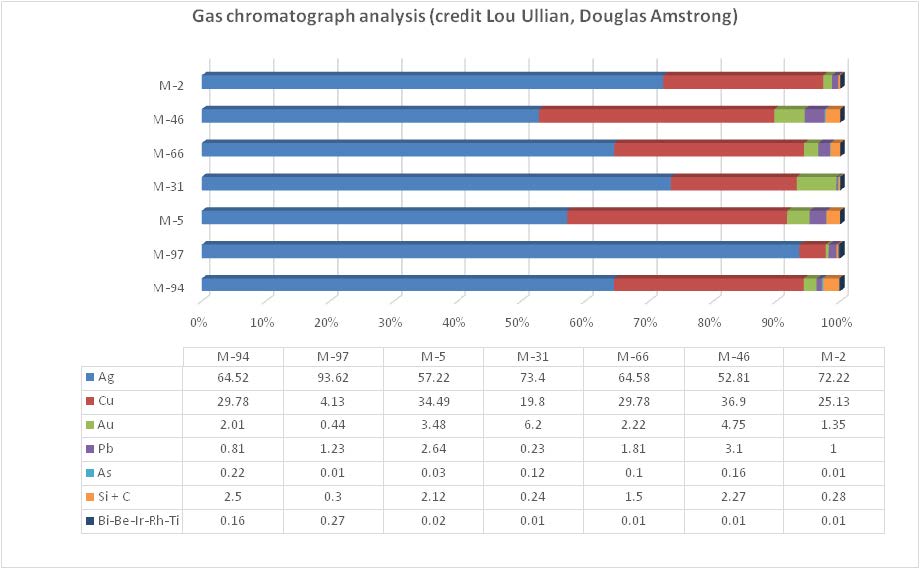
Note this analysis did not show any traces of mercury, known to be used for refining metals According to Encyclopedia Britannica, Bartolomé de Medina developed the “patio process,” a complex amalgamation procedure utilizing mercury, while mining in Mexico in the 1550s.. As we can see from the table, most of the bars sampled show a large amount of silver, ranging from 52% to 93%. The wide range of silver content poses a problem. Why is one bar (M-97) over 93% silver when the others average in the low-60% range? One explanation is that a chunk of native silver was used exclusively for the M-97 bar.
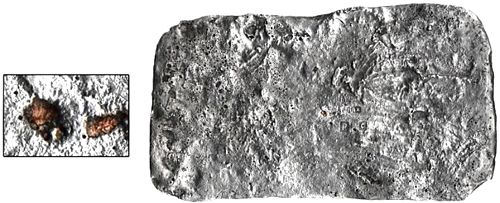
Embedded chunks of pure copper in “tumbaga” bar # M-83
A Study of the Markings and Bar Types
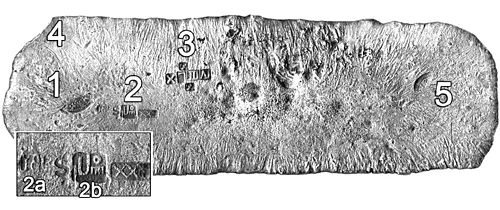
Example of a “tumbaga” bar assayed twice:
1 Partial tax stamp
2 Fineness stamp (modified Caroline style)
2a) Possible owner of the bar or quality-controller Ibáñez (IoBI3)
2b) Distinct punch for Modified Caroline style fineness
3 Fineness stamp (Roman square style)
4 Assay cut (“bite” Known as bocado in Spanish.)
5 Partial tax stamp
The royal tax stamp, or quinto, was a critical element added to each “tumbaga” bar after its creation. It ensured that the bar had been legally registered and a tax had been paid to the king for its creation. Most bars display several tax seals, all of which are incomplete. The partial (versus complete) impressions of the tax stamps markings is perhaps explained by the fact that the Spaniards did not want to submit the punches to excessive wear and tear (since these punches, fabricated mostly by the local blacksmiths, were of only average durability). Hence, only partial seals are visible, making the study of this element difficult. The cuñoTax stamp die mentioned in depositions by Cortés during his trial probably refers to this early tax stamp, a temporary improvisation until an official stamp came from Spain. The official Spanish stamp was later recorded as having the design of a shield with two snakes around the Pillars of Hercules with sea waves below and the legend “Nueva España,” Lawrence Leslie Anderson, The Art of the Silversmith in Mexico, 1519-1936, 286-287. evidently quite unlike the crude unofficial stamp Cortés used.
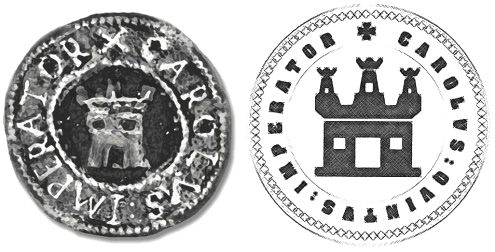 Below are two renderings of the early tax stamps on “tumbaga” bars. On the left is a composite of several different photos of actual tax stamps, and on the right is a digital rendering of a tax stamp created by Ernie RichardsPlus Ultra Newsletter, Vol. 2 Nr. 2 (En Rada Publications, FL, 1993).. The legend on the tax stamps was either CAROLVS IMPERATOR or CAROLVS QVINTVS IMPERATOR, although in this study of the “tumbaga” bars only the former was evident. It is known that there were about a dozen varieties of punches for the tax stamps Douglas R. Armstrong, op. cit., 13..
Below are two renderings of the early tax stamps on “tumbaga” bars. On the left is a composite of several different photos of actual tax stamps, and on the right is a digital rendering of a tax stamp created by Ernie RichardsPlus Ultra Newsletter, Vol. 2 Nr. 2 (En Rada Publications, FL, 1993).. The legend on the tax stamps was either CAROLVS IMPERATOR or CAROLVS QVINTVS IMPERATOR, although in this study of the “tumbaga” bars only the former was evident. It is known that there were about a dozen varieties of punches for the tax stamps Douglas R. Armstrong, op. cit., 13..
Another important element on the “tumbaga” bars is the marking for fineness. Four different styles of fineness stamps were used on these bars: Common Caroline, Roman Square, Modified Caroline, and Italic Caroline. (The example bar pictured above shows two different fineness stamps, Modified Caroline style and Roman Square style, but most bars were not stamped twice like this.) Of the 194 bars studied for my project, about 58% of them were stamped with the Common Caroline style, 22% with the Roman Square style, 18% with the Modified Caroline style and only 2% with the Italic Caroline style This total includes the bars sold at the Christie’s auction..
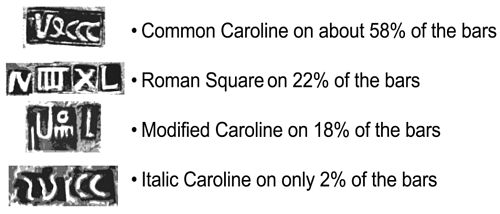 Common Caroline, the most common of all the styles and also known as the Carolingian style, was the standard form of writing in the Old World at the time the “tumbaga” bars were made. Roman Square, the second most common style, resembles Roman numerals inside squares. There were some unexplained modifications to standard Roman numerals, however. Instead of the Roman numeral “M” to denote the number 1000, the “tumbaga” stamps bear an “IV” that looks more like the letter “N,” which is similar to the Caroline style of “IU”. Also, the Roman numeral “D” for the number 500 is represented by a reverse open “G.”
Common Caroline, the most common of all the styles and also known as the Carolingian style, was the standard form of writing in the Old World at the time the “tumbaga” bars were made. Roman Square, the second most common style, resembles Roman numerals inside squares. There were some unexplained modifications to standard Roman numerals, however. Instead of the Roman numeral “M” to denote the number 1000, the “tumbaga” stamps bear an “IV” that looks more like the letter “N,” which is similar to the Caroline style of “IU”. Also, the Roman numeral “D” for the number 500 is represented by a reverse open “G.”
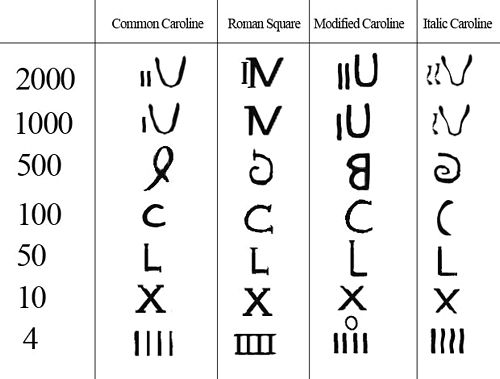 The third and probably most distinctive style is what Armstrong called Modified Caroline. Similar to the Common Caroline style, it is straighter and simpler, with some significant modifications as well: for example, the number 1000 is represented by a different-style letter “U” preceded by the letter “I,” so that 1000 becomes “IU”. Two letters “I” before the letter “U, or “IIU,” represents the number 2000, although this is rarely seen on “tumbaga” bars because not many of the bars were of high purity. Another peculiarity of the Modified Caroline fineness stamp style is the representation of the number 400 as Roman numerals “IIII” with a circle on top. Finally, the number 500 is represented by what looks like a mirror-image of a small capital “B,” as opposed to the Roman numeral D. The letter “S” usually preceded the fineness, and it probably represents a location of manufacture or possibly even a symbol for the assayer or owner. Finally, the rarest fineness stamp style, Italic Caroline, is similar to the Common Caroline but more wavy and usually accompanied with the marking “MS” which possibly represents the owner. “Tumbaga” bars with the Italic Caroline style of marking are usually non-standard shapes or weights, such as the “patties” or very long, heavy bars.
The third and probably most distinctive style is what Armstrong called Modified Caroline. Similar to the Common Caroline style, it is straighter and simpler, with some significant modifications as well: for example, the number 1000 is represented by a different-style letter “U” preceded by the letter “I,” so that 1000 becomes “IU”. Two letters “I” before the letter “U, or “IIU,” represents the number 2000, although this is rarely seen on “tumbaga” bars because not many of the bars were of high purity. Another peculiarity of the Modified Caroline fineness stamp style is the representation of the number 400 as Roman numerals “IIII” with a circle on top. Finally, the number 500 is represented by what looks like a mirror-image of a small capital “B,” as opposed to the Roman numeral D. The letter “S” usually preceded the fineness, and it probably represents a location of manufacture or possibly even a symbol for the assayer or owner. Finally, the rarest fineness stamp style, Italic Caroline, is similar to the Common Caroline but more wavy and usually accompanied with the marking “MS” which possibly represents the owner. “Tumbaga” bars with the Italic Caroline style of marking are usually non-standard shapes or weights, such as the “patties” or very long, heavy bars.
The best hypothesis to explain the use of four different fineness stamps on “tumbaga” bars is that assayers or owners created them to differentiate themselves from one another. While the Caroline style fineness stamps are usually accompanied by additional markings which will be discussed later, the Roman Square style stamp is almost always accompanied by two small marks above and below, which at first look like the letter “x” but are probably the letter “s” with a diagonal slash (rendered in full detail as “&” in the matrix at the end of my book. This was most likely some sort of seal to protect the alteration of the fineness in addition to being a mark for the bar’s producer.
 Example of a “tumbaga” bar assayed twice
Example of a “tumbaga” bar assayed twice
Note that some numbers are represented by the same character regardless of style. The letter “C” universally stands for 100, the letter “L” for 50, the letter “X” for 10 and the letter “I” for 1. All these representations of numbers are used to denote degrees of 2400 (pure silver). A curious sideline to this is that individual punches were also created that bore a combination of letters to represent a degree of fineness. Perhaps the die sinker was trying to save some time and energy.
| Bar# | Fineness | Fineness | Difference |
| M-135 | 1450 | 1420 | -2.07% |
| M-97 | 2300 | 2284 | -0.70% |
| M-84 | 1620 | 1650 | 1.85% |
| M-123 | 1350 | 1410 | 4.44% |
| M-55 | 1530 | 1620 | 5.88% |
| M-124 | 1270 | 1350 | 6.30% |
| M-93 | 1360 | 1475 | 8.46% |
| M-92 | 1240 | 1360 | 9.68% |
| M-151 | 1440 | 1580 | 9.72% |
| M-58 | 1220 | 1350 | 10.66% |
Chart showing the difference between the first and second assays on the twice-assayed bars
The “R” Code
 While all “tumbaga” bars bear one of the previously mentioned styles of fineness stamps, many bars also show another type of stamp which indicated a grosser measurement and thus was perhaps a stamp used more generically than the traditional fineness stamps. This mysterious stamp, the so-called “R” code stamp, always began with the letter “R” followed by other letters. While no one knows what the letter “R” stood for (reilera, rodelas, rey or rex, perhaps?), it is certain that in combination with other letters it indicated a category of fineness. “RL” described the purest bars, those that averaged in fineness around 2000 or higher out of 2400, while “RCxxx” described “tumbaga” bars with the lowest purity, those below 1000 out of 2400. “RC” and “RLxxx” described bars that fell somewhere in between in fineness.
While all “tumbaga” bars bear one of the previously mentioned styles of fineness stamps, many bars also show another type of stamp which indicated a grosser measurement and thus was perhaps a stamp used more generically than the traditional fineness stamps. This mysterious stamp, the so-called “R” code stamp, always began with the letter “R” followed by other letters. While no one knows what the letter “R” stood for (reilera, rodelas, rey or rex, perhaps?), it is certain that in combination with other letters it indicated a category of fineness. “RL” described the purest bars, those that averaged in fineness around 2000 or higher out of 2400, while “RCxxx” described “tumbaga” bars with the lowest purity, those below 1000 out of 2400. “RC” and “RLxxx” described bars that fell somewhere in between in fineness.

| Code | Bar # | Fineness | Ave. | Code | Bar # | Fineness | Ave. |
| RCxxx | M-17 | 700 | 834 | RLxxx | M-23 | 1610 | 1782 |
| M-1 | 780 | M-68 | 1710 | ||||
| M-29 | 840 | M-79 | 1820 | ||||
| M-28 | 880 | M-82 | 1870 | ||||
| M-18 | 970 | M-136 | 1900 | ||||
| RC | C-275 | 920 | 1150 | RL | M-90 | 1950 | 2090 |
| C-277 | 1020 | M-142 | 2000 | ||||
| M-51 | 1160 | M-118 | 2080 | ||||
| C-284 | 1220 | M-3 | 2190 | ||||
| C-281 | 1430 | M-128 | 2230 |
Table showing a sample of bars with different “R” codes16
It is possible that these “R” stamps were affixed to the bars to reflect some sort of original sorting of the looted treasure that went into their creation. Many of these bars were later recalled for re-assaying and show two or even (in a few instances) three assays, with the previous assay markings defaced to cancel them out.
Other Markings
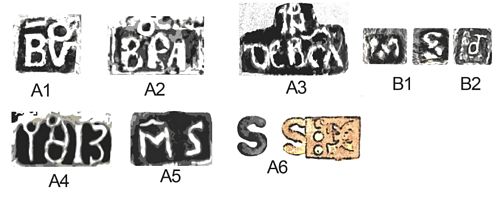 The last type of “tumbaga” bar markings may refer to ownership of the bars. Later ingots, such as bars from the 1622 Atocha wreck, bear similar markings composed of letters and symbols, each set unique to its owner. In Spanish Treasure Bars from New World ShipwrecksAlan K. Craig and Ernest J. Richards, Jr. Spanish Treasure Bars from New World Shipwrecks. West Palm Beach, Florida, En Rada Publications, 2003, the authors Alan K. Craig and Ernest J. Richards, Jr. conducted a detailed study of gold and silver treasure bars recovered from Spanish New World shipwrecks and, using the original Atocha manifest as a reference, they listed the owners of most of the 963 silver bars recovered from that shipwreck by matching the ownership mark on the manifest to an ownership mark on the bar. Unfortunately there is no known manifest (yet) for the “Tumbaga Wreck,” so the idea that the markings shown above are ownership stamps, while most plausible, is only theoretical.
The last type of “tumbaga” bar markings may refer to ownership of the bars. Later ingots, such as bars from the 1622 Atocha wreck, bear similar markings composed of letters and symbols, each set unique to its owner. In Spanish Treasure Bars from New World ShipwrecksAlan K. Craig and Ernest J. Richards, Jr. Spanish Treasure Bars from New World Shipwrecks. West Palm Beach, Florida, En Rada Publications, 2003, the authors Alan K. Craig and Ernest J. Richards, Jr. conducted a detailed study of gold and silver treasure bars recovered from Spanish New World shipwrecks and, using the original Atocha manifest as a reference, they listed the owners of most of the 963 silver bars recovered from that shipwreck by matching the ownership mark on the manifest to an ownership mark on the bar. Unfortunately there is no known manifest (yet) for the “Tumbaga Wreck,” so the idea that the markings shown above are ownership stamps, while most plausible, is only theoretical.

Bar # M-117 "the key bar" with a 1st Ley Fineness visible of 1400. Ley Type MC, with two quinto marks visible and a code control, only one assay cut. Weight 5.32 pounds and size 9 x 27 x 1.2 cm. This interesting bar was hammered all the way probably to cancel prior ownership and markings, also this piece has cut markings on the sides, probably for testing the metal.
Conclusions
The rare silver “tumbaga” bars found by Marex in 1993 are now a step closer to full understanding. Through a study of contemporary accounts, archeological research and historical sources, I have shown that these strange ingots were manufactured by the Spanish using a unique copper-silver “alloy” forged by the Tarascans in Mexico as a source for their ornaments and offerings, a particular type of metal the Spanish called “metal of Michoacán,” seized by the conquistadors in a single episode within the vast story of the conquest of Mexico during the 1520s.
One could say these so-called “tumbaga” bars are the involuntary inheritance of the unprepared conquistadors, who never envisioned a smelting operation in the first phase of the conquest. Lacking an official foundry to properly smelt and refine this new-found metal, the Spanish had to resort to Mesoamerican techniques, and also ended up using cryptic and temporary markings to denote purity, ownership, manufacture and—above all—payment of the royal fifth. Several of these markings are now deciphered, and I have also prepared a list of people who could have been represented in some way by the rest of these mysterious monograms and punches.
While we may never know how the bars ended up on a shipwreck in the Bahamas, one thing is for sure: the specimens studied in this project are the only ones known to exist—all of them from the same wreck—and therefore they will always be of the utmost rarity and historical importance.
